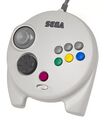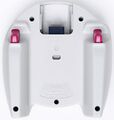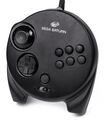Difference between revisions of "3D Control Pad"
From Sega Retro
| Line 16: | Line 16: | ||
}} | }} | ||
}} | }} | ||
| − | The '''3D Control Pad''', called the '''Sega Multi Controller''' (セガマルチコントローラー) in Japan and the '''Joystick 3D''' in Brazil, is a control pad developed for use with the [[Sega Saturn]]. Debuting with ''[[NiGHTS into Dreams]]'', it was [[Sega]]'s answer to the then revolutionary Nintendo 64 controller, which featured an analogue stick as opposed to relying solely on D-Pads | + | The '''3D Control Pad''', called the '''Sega Multi Controller''' (セガマルチコントローラー) in Japan and the '''Joystick 3D''' in Brazil, is a control pad developed for use with the [[Sega Saturn]]. Debuting with ''[[NiGHTS into Dreams]]'', it was [[Sega]]'s answer to the then revolutionary Nintendo 64 controller, which featured an analogue stick as opposed to relying solely on D-Pads. |
| − | The 3D Control Pad builds on the features already seen in the standard [[Control Pad (Saturn)|Saturn Control Pad]], containing an eight-direcional D-Pad and {{A}}, {{B}}, {{C}}, {{X}}, {{Y}}, {{Z}} and {{Start}} buttons. New to the controller | + | Analogue sticks generally allow for greater precision in a 3D environment, which in 1996 were becoming more common in the console video game market. |
| + | |||
| + | ==Hardware== | ||
| + | The 3D Control Pad builds on the features already seen in the standard [[Control Pad (Saturn)|Saturn Control Pad]], containing an eight-direcional D-Pad, and {{A}}, {{B}}, {{C}}, {{X}}, {{Y}}, {{Z}} and {{Start}} face buttons. New to the controller is an analogue thumbstick (or "3D Directional Pad" as Sega called it), positioned on the left hand side of the controller above the D-Pad. Also inlcuded are analogue {{L}} and {{R}} shoulder triggers, a first for mainstream video game controllers. | ||
To avoid compatibility issues, the analog controller has a switch under the start button to swap between "Digital" and "Analogue" modes. Switching to "Digital" mode disables all analogue settings, essentially turning the controller back into a standard control pad. This switch was vital, because earlier games were not built to understand the analogue technology and will not function correctly if the wrong mode is chosen. The original PlayStation and its latter dual-analogue controllers also required this feature. | To avoid compatibility issues, the analog controller has a switch under the start button to swap between "Digital" and "Analogue" modes. Switching to "Digital" mode disables all analogue settings, essentially turning the controller back into a standard control pad. This switch was vital, because earlier games were not built to understand the analogue technology and will not function correctly if the wrong mode is chosen. The original PlayStation and its latter dual-analogue controllers also required this feature. | ||
| − | + | The lead can also be removed from the controller for storage purposes. | |
The 3D Control Pad did not see widespread adoption for the same reason the Sega Saturn failed to capture a large share of the market in the west. The Saturn's 3D output was low, and as the controllers were never bundled with the console, consumers were more familiar with the standard Saturn control pads. It also has some design issues, namely the fact it is quite a lot bigger than most other controllers and arguably less comfortable than the standard pads for certain genres. Even in Japan, where the Saturn was successful, the controller was not used by many games (many of them coming from Sega, though some developers, such as [[KID]], supported it quite a bit (in their case, [[Kiss Yori...|even after Sega introduced the Dreamcast]])). | The 3D Control Pad did not see widespread adoption for the same reason the Sega Saturn failed to capture a large share of the market in the west. The Saturn's 3D output was low, and as the controllers were never bundled with the console, consumers were more familiar with the standard Saturn control pads. It also has some design issues, namely the fact it is quite a lot bigger than most other controllers and arguably less comfortable than the standard pads for certain genres. Even in Japan, where the Saturn was successful, the controller was not used by many games (many of them coming from Sega, though some developers, such as [[KID]], supported it quite a bit (in their case, [[Kiss Yori...|even after Sega introduced the Dreamcast]])). | ||
| − | The 3D Control Pad | + | The 3D Control Pad also works with games compatible with the [[Arcade Racer Joystick|steering wheel controllers]], and the [[Sega Mission Stick]]. |
| − | |||
| − | |||
| − | + | ==List of supported games== | |
| − | + | [[File:Icon-3dcontrolpadmark.png|thumb|right|200px|North American games which support the 3D Control Pad have this icon indicating compatibility on the back of the box.]] | |
| − | ==List of | + | :''note: this list is missing games not released in Japan and may use Japanese names for games released in the West as well'' |
| − | [[File:Icon-3dcontrolpadmark.png|thumb|right|200px| | ||
| − | :''note: this list is missing games not released in Japan and may use Japanese names for games released in the | ||
{{multicol| | {{multicol| | ||
*''[[Advanced World War Sennen Teikoku no Koubou: Last of the Millennium]]'' | *''[[Advanced World War Sennen Teikoku no Koubou: Last of the Millennium]]'' | ||
| Line 138: | Line 137: | ||
*''[[World Series Baseball II]]'' | *''[[World Series Baseball II]]'' | ||
|cols=3}} | |cols=3}} | ||
| + | |||
| + | ==History== | ||
| + | ===Development=== | ||
| + | The 3D Control Pad is one of Sega's most significant video game controllers, with Sega filing a patent covering a number of possible extensions to the design{{fileref|Patent US7488254.pdf}}, achieved through the port at the top of the controller. | ||
| + | |||
| + | Covered ideas include wireless connections to the console (and light gun-style support){{fileref|Patent US7488254.pdf|page=11}}, extra joysticks{{fileref|Patent US7488254.pdf|page=14}} and trackballs{{fileref|Patent US7488254.pdf|page=16}}, memory cards{{fileref|Patent US7488254.pdf|page=18}}, a second display{{fileref|Patent US7488254.pdf|page=19}}, clocks{{fileref|Patent US7488254.pdf|page=20}}, a curious rotatable stand{{fileref|Patent US7488254.pdf|page=21}} and motion control{{fileref|Patent US7488254.pdf|page=22}}. | ||
| + | |||
| + | Vibration feedback is also considered{{fileref|Patent US7488254.pdf|page=13}} which may pre-date attempts by Nintendo. | ||
| + | |||
| + | ===Release=== | ||
| + | Notably the 3D Control Pad beat the Nintendo 64 to market by a month in the US and several months in Europe, so while clearly inspired by the Nintendo 64 by design, the Sega Saturn can stand as the first video game console to support modern analogue stick support. | ||
| + | |||
| + | ===Legacy=== | ||
| + | The 3D Control Pad can be credited for many common features seen in controllers today, with its design greatly influencing that of the [[Dreamcast Controller|Sega Dreamcast Controller]]. Analogue shoulder buttons have since been adopted by both [[Nintendo]], [[Microsoft]] and [[Sony]] in the [[Nintendo GameCube]], [[Xbox]] and [[PlayStation 3]] (and their successors) and the placement of the analogue stick has also been copied by several firms. | ||
==Gallery== | ==Gallery== | ||
| Line 221: | Line 234: | ||
==References== | ==References== | ||
| + | {{multicol| | ||
<references /> | <references /> | ||
| + | }} | ||
{{Saturn}} | {{Saturn}} | ||
[[Category:Control pads]] | [[Category:Control pads]] | ||
Revision as of 10:23, 1 April 2016
This short article is in need of work. You can help Sega Retro by adding to it.
| 320x240px | |||||
| 3D Control Pad | |||||
|---|---|---|---|---|---|
| Made for: Sega Saturn | |||||
| Manufacturer: Sega | |||||
|
The 3D Control Pad, called the Sega Multi Controller (セガマルチコントローラー) in Japan and the Joystick 3D in Brazil, is a control pad developed for use with the Sega Saturn. Debuting with NiGHTS into Dreams, it was Sega's answer to the then revolutionary Nintendo 64 controller, which featured an analogue stick as opposed to relying solely on D-Pads.
Analogue sticks generally allow for greater precision in a 3D environment, which in 1996 were becoming more common in the console video game market.
Contents
Hardware
The 3D Control Pad builds on the features already seen in the standard Saturn Control Pad, containing an eight-direcional D-Pad, and ![]() ,
, ![]() ,
, ![]() ,
, ![]() ,
, ![]() ,
, ![]() and START face buttons. New to the controller is an analogue thumbstick (or "3D Directional Pad" as Sega called it), positioned on the left hand side of the controller above the D-Pad. Also inlcuded are analogue
and START face buttons. New to the controller is an analogue thumbstick (or "3D Directional Pad" as Sega called it), positioned on the left hand side of the controller above the D-Pad. Also inlcuded are analogue ![]() and
and ![]() shoulder triggers, a first for mainstream video game controllers.
shoulder triggers, a first for mainstream video game controllers.
To avoid compatibility issues, the analog controller has a switch under the start button to swap between "Digital" and "Analogue" modes. Switching to "Digital" mode disables all analogue settings, essentially turning the controller back into a standard control pad. This switch was vital, because earlier games were not built to understand the analogue technology and will not function correctly if the wrong mode is chosen. The original PlayStation and its latter dual-analogue controllers also required this feature.
The lead can also be removed from the controller for storage purposes.
The 3D Control Pad did not see widespread adoption for the same reason the Sega Saturn failed to capture a large share of the market in the west. The Saturn's 3D output was low, and as the controllers were never bundled with the console, consumers were more familiar with the standard Saturn control pads. It also has some design issues, namely the fact it is quite a lot bigger than most other controllers and arguably less comfortable than the standard pads for certain genres. Even in Japan, where the Saturn was successful, the controller was not used by many games (many of them coming from Sega, though some developers, such as KID, supported it quite a bit (in their case, even after Sega introduced the Dreamcast)).
The 3D Control Pad also works with games compatible with the steering wheel controllers, and the Sega Mission Stick.
List of supported games
- note: this list is missing games not released in Japan and may use Japanese names for games released in the West as well
- Advanced World War Sennen Teikoku no Koubou: Last of the Millennium
- Airs Adventure
- Astra Superstars
- Azel: Panzer Dragoon RPG
- Baroque
- Batsugun
- Battle Garegga
- Burning Rangers
- Can Can Bunny Extra
- Can Can Bunny Premiere 2
- Choro Q Park
- Code R
- Contra: Legacy of War
- Christmas NiGHTS
- Croc: Legend of the Gobbos
- Crypt Killer
- Cyber Speedway
- Daisuki
- Dark Savior
- Daytona USA: Championship Circuit Edition
- Daytona USA CCE Netlink Edition
- Daytona USA Circuit Edition
- Deep Fear
- Die Hard Trilogy
- Digital Dance Mix Vol.1 Namie Amuro
- Digital Pinball: Necronomicon
- Dungeon Master Nexus
- Duke Nukem 3D
- Enemy Zero
- Fantastep
- Fighters Megamix
- Formula Karts Special Edition
- Fuusui Sensei
- G Vector
- Gale Racer
- Greatest Nine '96
- GT 24
- Hang-On GP
- Hardcore 4x4
- Initial D
- J. League Go Go Goal!
- Jungle Park
- Kiss Yori...
- Magic Carpet
- Manx TT Superbike
- MechWarrior 2: 31st Century Combat
- Mystaria: The Realms of Lore
- NiGHTS into Dreams
- Ochige Designer Tsukutte pon!
- OoEdo Renaissance
- Over Drivin' GT-R
- Panzer Dragoon
- Panzer Dragoon Saga
- Panzer Dragoon Zwei
- Pebble Beach Golf Links
- Pia Carrot e Youkoso!!
- Planet Joker
- Power Drift
- Primal Rage
- Quake
- Rayman
- Ryuuteki Gosennen: Dragons of China
- Sega Ages
- Sega Ages After Burner II
- Sega Ages Galaxy Force II
- Sega Ages Memorial Selection VOL.2
- Sega Ages OutRun
- Sega Ages Power Drift
- Sega Ages VOL.2: Space Harrier
- Sega Rally Championship Plus
- Sega Touring Car Championship
- Sega Worldwide Soccer '98
- Shining Force III
- Shining Force III Scenario 2: Nerawareta Miko
- Shining Force III Scenario 3: Hyouheki no Jashinguu
- Shining Force III: Premium Disc
- Shining the Holy Ark
- Sky Target
- Sonic 3D: Flickies' Island
- Sonic Jam
- Sonic R
- Soukyugurentai
- Soviet Strike
- StarFighter 3000
- Syutokou Battle '97
- Taito Chase H.Q. Plus S.C.I.
- Tama: Adventurous Ball in Giddy Labyrinth
- The House of the Dead
- The Lost World: Jurassic Park (Saturn)
- Touge King the Spirits 2
- Virtuacall S
- Virtua Cop 2
- Virtua Racing
- Virtual Kyoutei
- Virtual Kyoutei 2
- Wing Arms
- Winter Heat
- Wipeout 2097
- World Cup '98 France: Road to Win
- World League Soccer '98
- World Series Baseball II
History
Development
The 3D Control Pad is one of Sega's most significant video game controllers, with Sega filing a patent covering a number of possible extensions to the design[1], achieved through the port at the top of the controller.
Covered ideas include wireless connections to the console (and light gun-style support)[2], extra joysticks[3] and trackballs[4], memory cards[5], a second display[6], clocks[7], a curious rotatable stand[8] and motion control[9].
Vibration feedback is also considered[10] which may pre-date attempts by Nintendo.
Release
Notably the 3D Control Pad beat the Nintendo 64 to market by a month in the US and several months in Europe, so while clearly inspired by the Nintendo 64 by design, the Sega Saturn can stand as the first video game console to support modern analogue stick support.
Legacy
The 3D Control Pad can be credited for many common features seen in controllers today, with its design greatly influencing that of the Sega Dreamcast Controller. Analogue shoulder buttons have since been adopted by both Nintendo, Microsoft and Sony in the Nintendo GameCube, Xbox and PlayStation 3 (and their successors) and the placement of the analogue stick has also been copied by several firms.
Gallery
Physical scans
| Saturn, US (NiGHTS into Dreams) |
|---|
| Saturn, EU (NiGHTS into Dreams) |
|---|
| Saturn, JP (NiGHTS into Dreams) |
|---|
| Saturn, JP (Magic Carpet) |
|---|
External links
References
- ↑ File:Patent US7488254.pdf
- ↑ File:Patent US7488254.pdf, page 11
- ↑ File:Patent US7488254.pdf, page 14
- ↑ File:Patent US7488254.pdf, page 16
- ↑ File:Patent US7488254.pdf, page 18
- ↑ File:Patent US7488254.pdf, page 19
- ↑ File:Patent US7488254.pdf, page 20
- ↑ File:Patent US7488254.pdf, page 21
- ↑ File:Patent US7488254.pdf, page 22
- ↑ File:Patent US7488254.pdf, page 13




















